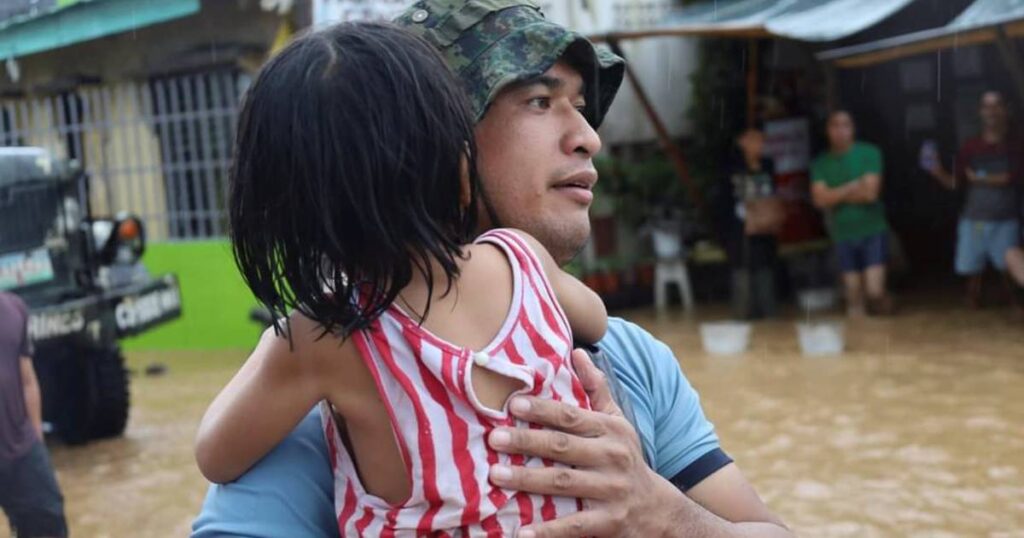At least 42 people were killed, 16 are still missing, and several residents are trapped on their roofs after flash floods and landslides triggered by torrential rains overwhelmed a southern Philippine province, officials said on Friday (local time).
Most of the victims were swept away by rampaging floodwaters and drowned or were hit by debris-filled mudslides in three towns in hard-hit Maguindanao province, said Naguib Sinarimbo, the interior minister for a five-province Muslim autonomous region run by former guerrillas.
Forecasters said Tropical Storm Nalgae, which was anticipated to slam into the nation’s eastern coast from the Pacific Ocean on Saturday (local time), was the cause of the exceptionally heavy rainfall.
The stormy weather prompted the coast guard to prohibit sea travel in dangerously rough seas as millions of Filipinos planned to travel over a long weekend to visit the tombs of relatives and for family reunions on All Saints’ Day in the largely Roman Catholic nation.
According to Sinarimbo, “the amount of rains that fell down overnight was abnormally (heavy) and ran down mountain sides and filled waterways.”
Sinarimbo said, adding that the rains have abated, causing flooding to start to ebb in numerous towns. “I hope the casualty numbers won’t grow more but there are still a few areas we haven’t reached,” he said.
According to reports from mayors, governors, and disaster response officials, 27 people died in Datu Odin Sinsuat town, Datu Blah Sinsuat town, and Upi town, all in Maguindanao, primarily from drowning and landslides.
According to Sinarimbo, six people were reported missing in Datu Blah Sinsuat and ten more in Upi.
A rescue team reported that the bodies of at least 11 villagers were recovered in Kusiong, a tribal village at the foot of a mountain in Datu Odin Sinsuat, where floods and landslides also hit houses in the community, Sinarimbo said.
He added that it was unclear how many people were still missing in Kusiong due to uncertainty following the disaster that struck the hamlet. “They were able to rescue some earlier but now they’re only trying to dig out bodies there,” he said.
Army officials also reported at least 42 storm deaths in Maguindanao and said in a statement that their forces were “continuing to rescue those trapped in the flood in collaboration with local disaster teams” and take the displaced in army trucks to evacuation camps.
In a mountainous area with swampy plains, the exceptionally strong rains inundated numerous towns in Maguindanao and neighbouring provinces.
Many low-lying communities saw quick rises in floodwaters that forced some inhabitants to climb onto their roofs, where they were saved by army personnel, police officers, and volunteers, according to Sinarimbo.
Many of the swamped areas had not been flooded for years, including Cotabato city where Sinarimbo said his house was inundated.
Disaster-response official Nasrullah Imam described a town in Maguindanao that had been completely submerged by floodwaters as having “just the attic of a school can be seen above the floodwater in one spot in Upi.”
Nalgae, the 16th storm to hit the Philippine archipelago this year, was able to dump rain in the south of the nation while moving farther north, according to official forecaster Sam Duran.
The storm, which had sustained gusts of up to 85 kilometres per hour and was travelling northwest, was located about 180 kilometres east of Catarman town in Northern Samar province as of late Friday afternoon (local time).
Numerous provinces and cities, including the capital of Manila, were on storm alert. Fishing and cargo boats and inter-island ferries were barred from venturing out to sea, stranding thousands of passengers, the coast guard said.
In order to protect them, some 5000 people were moved out of the storm’s path. Government forecasters and other officials stated that the storm would not intensify into a typhoon as it reached land.
Each year, the archipelago of the Philippines is hit by about 20 typhoons and hurricanes.
It is located on the Pacific Ring of Fire, a region along most of the Pacific Ocean rim where many volcanic eruptions and earthquakes occur, making the nation one of the world’s most disaster-prone..
South Philippines floods and landslides claim at least 42 lives.

